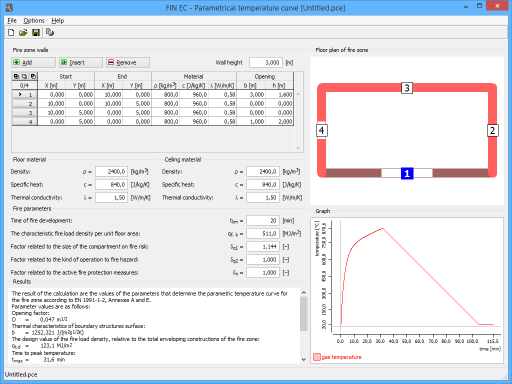Program Parametric temperature curve
This program calculates the characteristics of the parametric temperature curve according to the specified fire load and topology of the fire compartment.
General rules
The window contains input part on the left side, the compartment topology in the right upper corner and the results in the bottom part of the window. Documentation can be printed with the help of the window "Print and export document", that may be launched from main menu ("File" - "Print"), from the horizontal toolbar or with the help of the shortcut Ctrl+P.
There's an option to specify general data of the project (identification details, design standard), that may be used in heading and footing of documents. These data are organized in the window "General project data", which can be launched with the help of the main menu ("Options" - "Project"). The program also contains the window "About the company" with identification data of the company (contacts, list of designers etc.). Content of this window is shared for all Fin EC programs. Also these inputs may be added into documentation. This window can be opened with the help of link "Company" in the part "Options" of the main menu.
Following inputs affects the calculation of parametric temperature curve:
Fire zone walls
This part contains a table for the input of compartment topology. The shape of the compartment isn't limited. The maximum wall height is 4m, which is the fundamental limit for parametric curve according to the EN 1991-1-2. Any wall may contain one opening. More openings in one wall has to be specified as one opening with the width, that is equal to the sum of widths of all openings in the wall, and width the area, which is equal to the sum of areas of all openings. The materials of walls are described by the density, specific heat and the thermal conductivity. The materials of particular walls may differ.
Materials of floor and ceiling
These parts contain characteristics of floor and ceiling, the characteristics are identical to the properties of the walls material.
Fire parameters
Following parameters are necessary for the calculation:
Time of fire development tlim |
|
Characteristic fire load density per unit floor area qf,k |
|
Factor related to the fire activation risk due to the size of the compartment δq1 |
|
Factor related to the fire activation risk due to the type of occupancy δq2 |
|
Factor related to the different active fire fighting measures δn |
|
Results
The results are displayed in three different ways. First, the parametric temperature curve is displayed as a graph, which shows the dependency of gas temperature in time. Second option are following four parameters, that describe this curve:
O |
|
b |
|
qt,d |
|
tmax |
|
These parameters are suitable for following calculations in other programs (e.g. "Steel Fire", "Concrete fire"). The third way shows the expressions, that describe the curve course. First phase (heating) of the curve is described by the exponential curve, second phase (cooling) is a straight line. These expression may be used for the calculation of gas temperature for arbitrary time.
 Main application window
Main application window